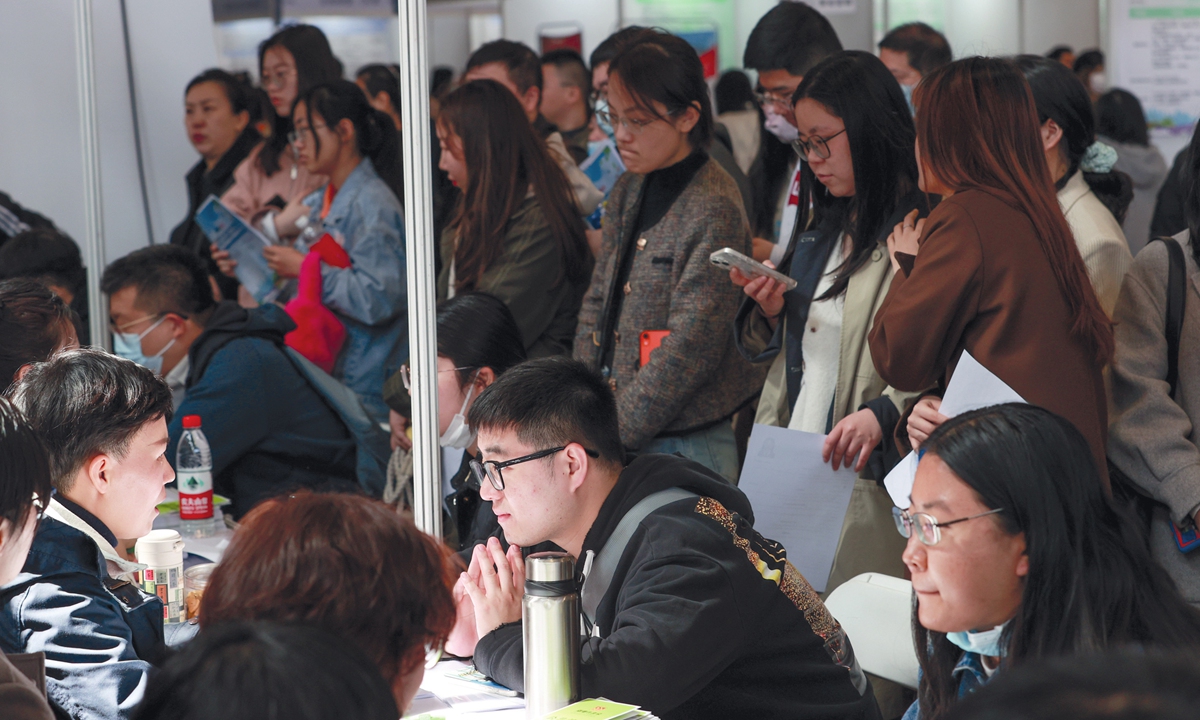

A recruiter explains job responsibilities to applicants at a recruitment fair in Shenyang, Northeast China's Liaoning Province, on February 28, 2024. The fair has gathered more than 2,000 enterprises, offering nearly 40,000 jobs. In order to boost employment, job fairs are being held nationwide. Photo: VCG
Economic growth drives job creation, so stable employment is inherently reliant on sustained economic growth. Over the past few decades, China's economy has grown rapidly, particularly the labor-intensive manufacturing sector, which has boosted non-agricultural jobs for tens of millions of rural laborers, leading to an unprecedented expansion in employment.
Now, the country's demographic patterns and the supply-demand relation of the workforce keep evolving. The structural transformation and industrial upgrade are accelerating the change in worker skill demands, posing new challenges for employment.
Although structural employment issues have emerged during the rapid economic transformation, the prospects for both the quantity and quality of employment are promising under the premise of continued economic stability.
In the first quarter of 2024, the ongoing economic recovery has provided necessary support for stable employment. China's economy has experienced a continued rebound, with its GDP growing by 5.3 percent year-on-year. The surveyed urban unemployment rate stood at 5.2 percent on average, a decrease of 0.3 percentage points from the first quarter in 2023.
China's current national economy has shown a clear path to a sustained recovery, with its stable economic foundation boosting job creation.
According to the estimation by a research team at the Chinese Academy of Social Sciences, the natural unemployment rate stood at 5.24 percent in January and slightly higher at 5.27 percent in February this year, with almost no cyclical unemployment that aligns with economic fluctuations.
The rise in cyclical unemployment rate was primarily caused by the impact of COVID-19 from 2020 to 2022. Migrant workers, often concentrated in market-oriented sectors and very sensitive to economic changes, serve as indicators of short-term economic cycles in China. In the first quarter of 2024, the unemployment rate among migrant workers was 5 percent, lower than the average surveyed urban unemployment rate of 5.2 percent.
The number of migrant workers in this period was estimated at 185.88 million, up 2.2 percent year-on-year, reflecting a sustained cyclical recovery in the economy, which contributed positively to creating new jobs.
As the elasticity of non-agricultural employment remains stable, it can be said that continued economic growth would lead to stable job creation. Compared to the past when massive rural surplus labor pressured job creation, the current scenario presents a more sustainable approach marked with a largely stable urban employment situation.
The manufacturing sector is always an important pillar of the economy and ensures the creation of more jobs. Since China's economic reforms and opening-up, the rapidly developing labor-intensive manufacturing sector has become the most significant source of job creation.
According to the seventh national census, employment in China's manufacturing sector exceeds 120 million workers, accounting for 22.7 percent of non-agricultural jobs. In the first quarter of 2024, the manufacturing sector grew by 6.7 percent, with employment remaining stable.
Observing changes in the Manufacturing Purchasing Managers' Index (PMI), it has experienced a rapid rebound as well as fluctuations since the government lifted strict COVID-19 control measures since early 2023. PMI improved in March to come in at 50.8, bouncing back to the expansion zone from 49.1 in February, indicating a recovery in manufacturing.
Further analysis of the Consumer Price Index (CPI), another key economic indicator, suggests that manufacturing is poised for further improvement. From the economic cycle perspective, CPI primarily reflects consumer demand and purchasing power for goods and services, while the PMI closely represents the production, sales, and purchasing plans and execution on the supply side.
Historically, CPI has been a leading indicator for manufacturing PMI by about one quarter. In the first quarter of 2024, core CPI, excluding energy and food prices, grew by 0.7 percent year-on-year, indicating a possible PMI rebound in the coming months.
First-quarter data showed that the value added by high-tech manufacturing grew by 7.5 percent, outpacing the overall manufacturing growth rate. Field research in the country's eastern coastal regions reveals significant improvements in the business conditions of advanced manufacturing enterprises in sectors including medical care, new materials, new energy, and computing equipment. This suggests traditional as well as new manufacturing sectors will continue to create more jobs and drive employment in the future.
The broad service sector, which has displayed a stronger role in job creation, has become even more vital, now accounting for nearly 50 percent of overall urban jobs in Chinese cities. The non-manufacturing sector, dominated by services, has shown a stronger recovery trend than manufacturing. The sector accounts for 53 percent of overall employment in March 2024.
In the three main sectors of the economy, the service industry is strong in creating jobs, and it now accounts for 59 percent of the GDP in the first quarter of 2024, with its rapid recovery increasingly driving employment.
Moreover, the service industry is also creating new types of flexible jobs, which can effectively mitigate short-term structural unemployment, and lower the natural unemployment rate.
Flexible employment provides a buffer for those temporarily struggling to find a job. It is effective in landing jobs for new migrant workers and college graduates. The "reservoir" role of flexible employment in the service sector maximally reflects its capacity to "buffer" against unemployment and its "inclusiveness" in job creation.
As one of the "troika" economic growth drivers, export also plays a crucial role in expanding employment and fostering economic growth. With the continued economic recovery, the first quarter of 2024 saw a 4.9-percent increase in total export volume, promising further enhancement in employment opportunities.
The increase in production scale driven by exports not only creates jobs in the export industries but also boosts employment in related sectors through the multiplier effect. And, improvements in the quality of export items and optimization of the export structure are expected to aid overall employment.
In the first quarter, net exports of goods and services contributed 14.5 percent to China's GDP, boosting GDP by 0.8 percentage points. Moreover, exports promote high-quality employment by driving technological progress and structural optimization.
The expansion of employment driven by exports can further stimulate domestic consumption. The increase in imports of bulk commodities and consumer goods reflects a positive development trend in home production and consumption. By enhancing the fundamental role of consumption in economic development, it will further stabilize economic growth and achieve a beneficial interaction between economic development and employment promotion.
The author is a research fellow at the Institute of Population and Labor Economics, Chinese Academy of Social Sciences. bizopinion@globaltimes.com.cn

Qu Yue Photo: Chinese Academy of Social Sciences



